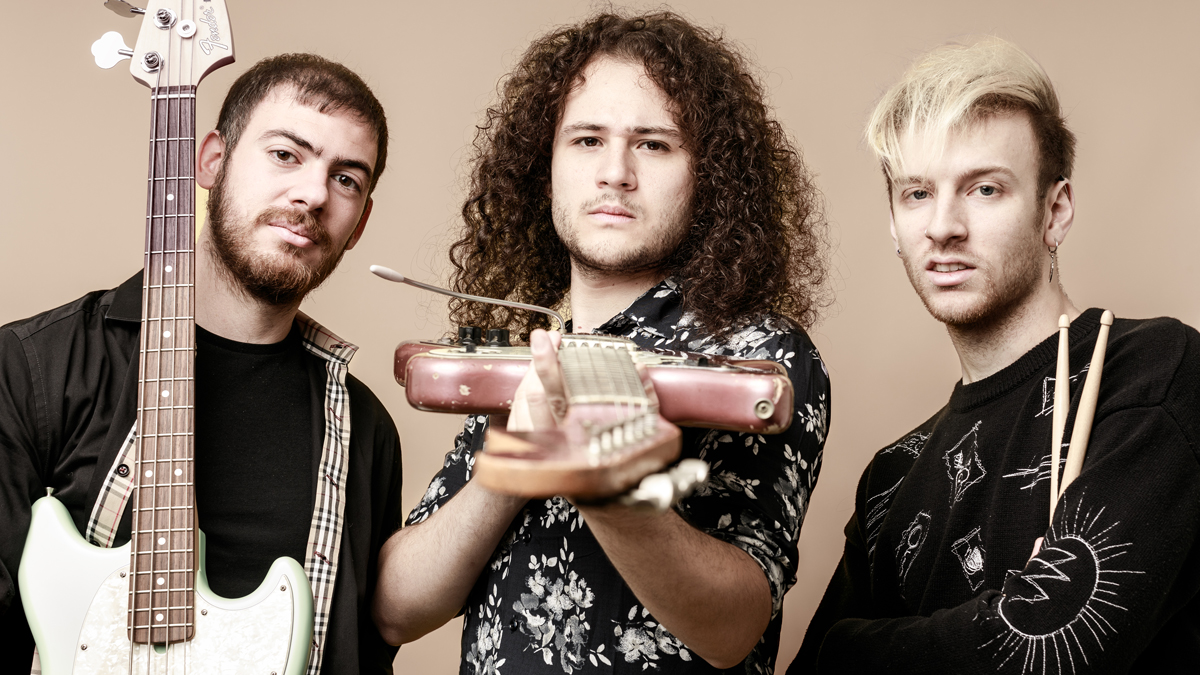“Guitar Hero was such an important tool for exposing kids from the late-’90s to the electric guitar. We’ve got some guitar heroes now – 10 years ago, we didn’t”: Michael Rubin went from playing video games to rocking vintage guitars with King Falcon
He has an awe-inspiring collection of vintage guitars, all with stories to tell, and he plays in one of NYC’s most exciting indie-rock bands. But as Michael Rubin tells it, it all started with Guitar Hero…

If you thought playing video games for hours upon hours could yield no transferable life skills, think again.
According to King Falcon guitarist Michael Rubin, a borderline unhealthy obsession with Guitar Hero was what set him on the six-string path and acquainted him with the greats of rock ’n’ roll.
“It’s funny, looking back, I think Guitar Hero was actually super-important culturally because, during the early 2000s, there was a kind of gap where there were no guitar heroes,” he tells us, speaking from the band’s HQ in NYC, just after loading up the van for a string of live shows.
“For the kids who were born in the late-’90s, Guitar Hero was such an important tool for getting them exposed to the electric guitar because there wasn’t music on the radio that had that. Now I think we’re seeing the effects, because there’s a bunch of guitar players from 2010 on. We’ve got some guitar heroes now, whereas 10 to 12 years ago, we didn’t!”
Teased by his father about his commitment to the game (we’re talking nailing a perfect score on Cliffs of Dover levels of commitment), Michael picked up an actual guitar and enrolled in the School of Rock when he was 10 years old. Since then, he’s been honing his chops and building a drool-worthy collection of unique vintage instruments, several of which can be heard on King Falcon’s self-titled debut album, which was released this October via Mascot Records.
“All the guitars on the record are vintage,” beams Michael, whose collection of rare gems includes everything from a 1963 Sonic Blue Jazzmaster nicknamed Lynn after its original owner, to an ultra-rare 1966 Gibson Trini Lopez in Factory Black, to a pristine 1965 Kerry Green Firebird V.

There’s a 1962 Burgundy Mist Jaguar that he liberated from a Brooklyn basement, a faded “Candy Apple Orange” ‘67 Jazzmaster and the guitar that started his whole collection: a ‘69 Tele that Michael purchased aged 16, when the number 69 was naturally a hilarious bonus selling point.
All the latest guitar news, interviews, lessons, reviews, deals and more, direct to your inbox!
All in all, he estimates that his ever-growing family totals around 50 instruments, but the one that “put in the most work” on the album was a much-loved 1955 Les Paul Goldtop called Doris – again, christened in honor of its original owner.
“That’s mostly a studio only guitar,” says Michael with deep reverence. “It’s beautiful – sounds amazing – but it’s very fragile. The reason I don’t play that guitar out is because Doris kept it in such good shape. She never played it with a strap, so the back of the guitar doesn’t have any wear. If I play it standing up, I’m going to be the first guy in 60-plus years to put wear on it, and it kind of feels disrespectful.”
If you want to feast your ears on the real diversity of his collection, then the go-to song has to be On Your Soul. A driving indie-rock banger with shimmering layers and some delicious guitarmonies, Michael reckons it’s “probably the song with the most gear” of the whole 11-track collection.
For the rhythm parts, he used a ‘57 Strat on the neck pickup as well as a ‘67 ES-345 for a contrasting tone.
“Those are chorused and they’re going through a 1964 Fender Princeton,” he notes, “and the color guitar that just does strums is the 1962 Burgundy Mist Jaguar.” All the leads were performed on Doris the Goldtop, played through a 1974 Silverface Fender Deluxe Reverb that Michael picked up in non-working order for $100 at a garage sale and fixed up nicely himself.
Lastly, he used a modern T-Rex Replicator Tape Echo for its authentically vintage-sounding delays, rather than trying to tangle with a finicky old Echoplex.
I find my one favorite Les Paul, and I’ll have two versions of it: one that goes on the road and one that stays home. But that’s it
Like many of us, Michael finds the allure of vintage guitars simply more irresistible than anything fresh off the factory line. For him, the very best instruments should feel “like an old pair of jeans that just fits right”. And, although his collection might be large, he’s very thoughtful and by no means greedy in approach to acquisition.
“I like to collect things that serve different purposes,” he explains. “I find my one favorite Les Paul, and I’ll have two versions of it: one that goes on the road and one that stays home. But that’s it. There are some guys who like Les Pauls and they have to have 50! For me, I tend to pick one favorite and move on.”
His other rule of thumb is that a guitar must either have some kind of inherently quirky, characterful appeal – like his current favorite 1970 SG for touring, which has “holes drilled in it” and a bunch of non-original parts – or, it must be a “historically significant” piece.
“With some of the prototypes that Fender and Gibson made, it’s not like they’re the best guitars in the world, because they were still figuring it out,” says Michael.
“But you see one of those and it’s absolutely breathtaking because you’re like, ‘This was a pivotal moment in the design of guitars.’ However, being a guy who tours and is a player, every time I play a guitar that really speaks to me and just sings a certain way, it doesn’t matter what the history is.”

If one thing’s for sure, it’s that Michael has put in the research hours, as well as the practice time, when it comes to each and every one of his vintage instruments, and he pairs an encyclopedic knowledge with an infectious kind of enthusiasm that makes you want to go hunting for old gold yourself.
Asked if he has any advice for those just venturing into the vintage market, he offers the most unbelievable story to illustrate his buying philosophy, so it feels only right that we let him tell it in full.
“My favorite guitar in my collection is not the rarest or the most valuable guitar,” he teases. “It’s a 1957 Stratocaster but it’s refinished. The first time I saw it, I was 11 or 12 years old and we were playing in a church parking lot. After the gig, this old Italian guy came up to me and was like, ‘Hey, I've got this old Fender Stratocaster. Maybe you want to come take a look.’
“The next day, I go over to his house with my mom and he takes this thing out and it’s a beautiful guitar. It had the most flamey neck that you’ve ever seen. After playing it for a little while I asked him how much he wanted and it was a couple of thousand dollars. Being a 12-year-old kid, I didn’t have a couple of thousand dollars. So I had to let it go, but I never forgot about that guitar.

“Nine years went by. We were just starting King Falcon and I remembered this guitar. I decided to give the guy a phone call. Surprisingly, he answered. He was living about a quarter of a mile away, so I walked over to his house, spent about two or three hours with the guy and I finally paid him for the guitar and I left.
“A couple of weeks go by and my grandfather comes over, sees the guitar and goes, ‘Wait a second, I know that guitar! How do you know Filippo?’
“What’s crazy is that my grandfather was in a band with him in the ‘60s in Italy and that was the guitar he played. It kind of added this whole new element. You can’t buy that and you can’t manufacture that.”
Smiling as he reaches the end of the tale, Michael concludes: “If you approach vintage guitars in a way where it’s about becoming a custodian of them and it’s not just about trying to make a quick buck and flip guitars, you’ll do alright.”
- King Falcon’s self-titled debut album is out now via Mascot.
Since graduating university with a degree in English, Ellie has spent the last decade working in a variety of media, marketing and live events roles. As well as being a regular contributor to GuitarWorld.com, she currently heads up the marketing team of a mid-scale venue in the south-west of England. She started dabbling with guitars around the age of seven and has been borderline obsessed ever since. She has a particular fascination with alternate tunings, is forever hunting for the perfect slide for the smaller-handed guitarist, and derives a sadistic pleasure from bothering her drummer mates with a preference for wonky time signatures.


